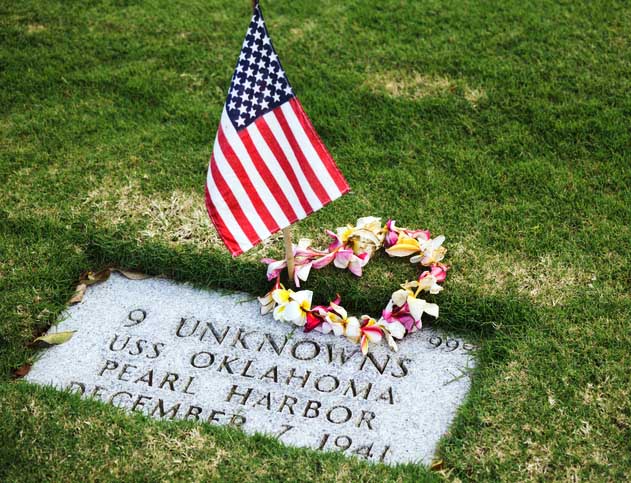Pearl Harbor: 75th Anniversary & Future Asbestos Dangers for Veterans

Seventy-five years later, Dec. 7, 1941, still lives in infamy.
Wednesday marks the 75th anniversary of the attack on Pearl Harbor. The surprise Japanese military strike killed 2,403 Americans and wounded another 1,178, devastating the U.S. naval base and dragging the nation into World War II.
But the death toll continued to rise decades after the attack because more than 10,000 veterans who served in Pearl Harbor were exposed to deadly asbestos released at the shipyards on the day of the attack.
As we remember the lives lost in the attack and honor the survivors still with us today on Pearl Harbor Day, it is important to also reflect on what all U.S. military veterans sacrifice to keep our nation free and safe.
Former U.S. Army Capt. Aaron Munz, who serves as director of the Veterans Department at The Mesothelioma Center, said the anniversary of Pearl Harbor “speaks to the incredible selflessness and the willingness of veterans to serve and protect their families and friends during a time of war.”
“Today, men and women of our military continue that self-sacrifice around the world in order to keep our country safe at home,” Munz said.
The ‘Unforeseeable’ Threat of Asbestos for Military Veterans
Munz knows that sacrifice as much as anyone.
He served nine years in combat and strategic planning and received the Bronze Star Medal for Valor in 2004 during Operation Iraqi Freedom. Both grandfathers served in World War II, one in the Navy and the other in the Army.
Now, Munz dedicates his time to helping military veterans with a different battle — guiding them and their families through the complex Veterans Administration (VA) benefits claims process.
While millions died defending our freedom, approximately 10,000 veterans die each year from asbestos-related diseases. The U.S. military embraced asbestos as a useful fireproofing material, especially on naval ships between the 1930s and 1970s.
Asbestos-related diseases carry an unusually long latency period, or the gap in time between exposure and illness. Mesothelioma, a rare cancer caused almost exclusively from exposure to asbestos, has a median latency period of 20 to 50 years.
“This means even if the disease was not diagnosed until well after your military career ended, you may still be eligible for benefits,” Munz explained. “I recently spoke with one veteran diagnosed 60 years after first exposure.”
Munz acknowledged how the threat of asbestos exposure or exposure to other toxic materials is usually the “furthest concern” for service members.
“Most are focused on the combat mission at hand,” he said. “That’s the primary focus, not the long-term health effects of chemicals or materials they may be exposed to.”
Who Are the Veterans Most at Risk of Asbestos Exposure?
Veterans of all branches of the military were exposed to asbestos. Anyone who worked on U.S. Navy vessels built prior to 1980 is most at risk.
According to a recent report from the U.S. Department of Veterans Affairs, there are nearly 700,000 living veterans of World War II. Munz noted that because of the latency period and short life expectancy of mesothelioma and other asbestos diseases, it’s rare to find World War II survivors currently living with mesothelioma or other asbestos-related cancers.
Less than 33 percent of people 75 or older diagnosed with mesothelioma survive one year.
“Just because of the age, you’re talking people who were exposed 70-plus years ago,” Munz said. “We still have a few guys closing in on 90 years old at the youngest.”
The group most affected right now is Vietnam War veterans, Munz said, along with any veterans who served in the 1960s and 1970s.
While awareness has increased in recent years in part to mesothelioma commercials and advocacy organizations, Munz said general awareness and knowledge of asbestos-related diseases is low among veterans.
“There are still a large percentage of veterans who don’t know they are eligible for a VA disability claim for a service-connected illness,” Munz said. “There’s certain eligibility the VA requires that we can help explain and establish a history of asbestos exposure during military service.”
Distinguishing when exposure occurred can be difficult. According to Munz, at least 50 percent of people exposed in service continued to work with asbestos in some capacity after leaving the military.
The Veterans Department at The Mesothelioma Center can help pinpoint the main root of asbestos-related diseases. Munz noted that someone who breathes in asbestos dust from shingles on a roof is different than someone working in a boiler room on a ship.
“We try to determine the intensity of the exposure,” Munz said. “Someone on a Navy ship exposed 24 hours a day and seven days a week during a tour is different than working in a factory or a construction site and then going home and breathing in clean air at night.”
The Future of Veterans and Mesothelioma
Although asbestos is no longer used in the military, that doesn’t mean the threat of asbestos diseases shouldn’t be a concern for active service members and recent veterans.
Today, there is a different set of soldiers at risk.
While recent veterans and active duty members may not be exposed to asbestos in engine and boiler rooms of naval ships, they are at risk for exposure while on duty in different parts of the world, especially in developing nations where asbestos is still used heavily.
So as we reflect on a landmark anniversary of the Pearl Harbor attack, let us keep in mind current and future veterans of all ages, military branches and type of service still face many issues today, long after their time serving our country ends.